Latest
Bass Musician Magazine’s Year of the Luthier – George and Marcel Furlanetto
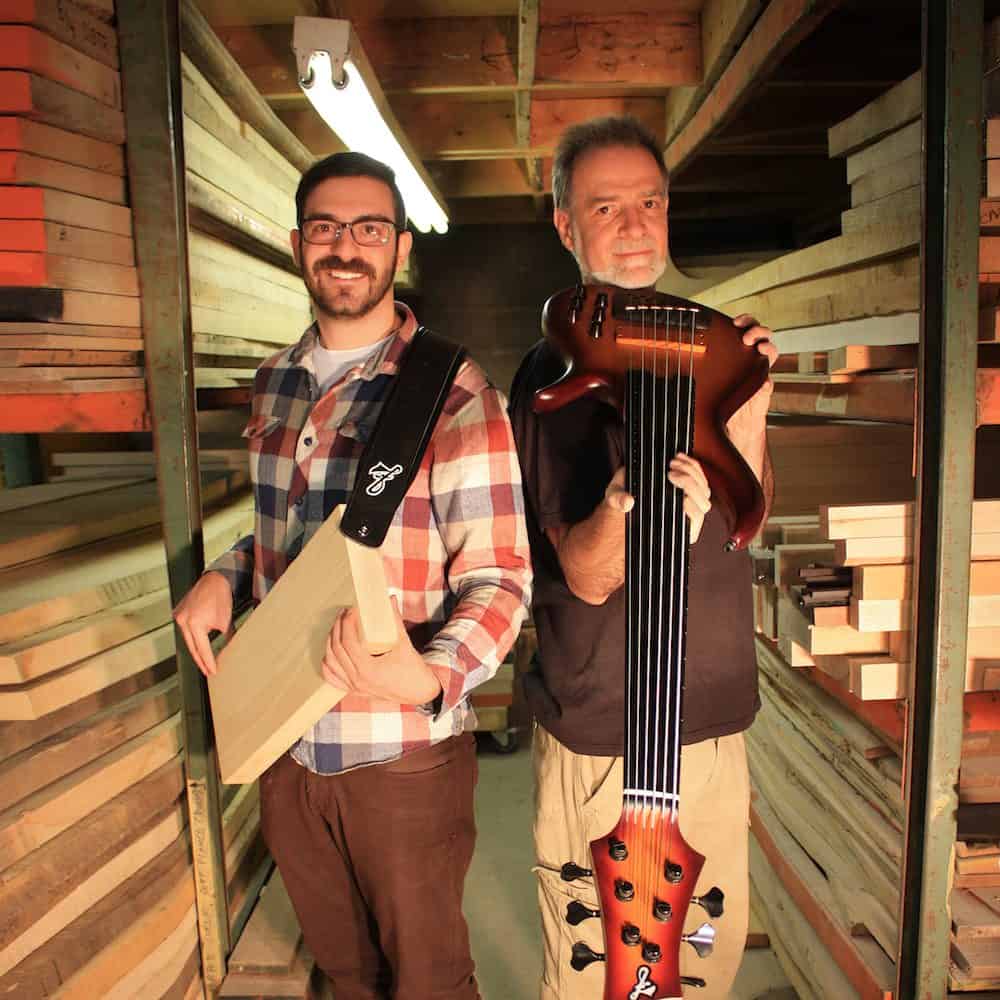
Interview with Luthiers George and Marcel Furlanetto, F Bass –
F Bass – Past, Present and Future…
KG: George, F Bass has been around for many years. How and when did you get started?
GF: A friend introduced me to guitar when I was 16; that was 1967, right in the middle of guitar-centred, rock music era. I loved it instantly, learning from the instructional Ventures records. Throw into that mix my interest in improving things, and I started tinkering with guitars. I think I have to credit my parents’ inherited genes; my dad was a very good artist and craftsperson, as well as being able to repair almost anything, and my mom had a fabulous, natural singing voice.
In 1969 I started doing guitar repairs in a well-established, local music store. By a stroke of luck (mine), their repairperson had been AWOL for two weeks. In 1976 I opened my own repair business and built my first electric guitar that year. The first electric bass build came in 1978.

George in Gage Park, 1980
KG: Marcel, when did you join your father’s business and what prompted you to do so? What would you say your role is at F Bass right now?
MF: While growing up I was fortunate enough to be surrounded by all facets of music, but it was gear itself that really drew my attention. I was fascinated with the construction of guitars & basses, their history/origin, the tonal variation between wood species, strings, hardware, and many other components. It was actually a little embarrassing how excited I got over wood…there’s a better way to put that…but I haven’t found it yet. At the age of 16 my father guided me through my first proper guitar and bass builds, it was at this point that he allowed me to get my hands dirty with F Basses. I started off on knob duty (yup, those are handmade as well) and graduated to various stages of production before delving into business studies. After snagging a couple of diplomas in Business by 2010, I turned my full attention to F Bass Artist Relations, Customer Support, Marketing, R&D, Sales, etc.

KG: Who are some of the artists you have worked with in the past and how would you they have helped to shape F Bass?
GF: It started out with a few local bassists until a mutual friend in Montreal introduced me to UZEB in 1982. I first built synth loaded guitars for Michel Cusson, the guitarist in the band, then in 1983 I convinced Alain to play a 5-string rather than the 32-fret 4-string he was playing. The relationship blossomed as he and I had similar tastes in bass and tone. He is very analytical in all aspects of his music and instrumentation, so he helped in the development of his signature fretless model as well as his fretted. As a highly respected and visible artist in the bass community, he helped immensely in the sale of basses from that time on.

The other prominent artists at that time were, Marcus Miller, Tom Hamilton of AEROSMTH, Mike Porcaro of TOTO, and Myron Dove of SANTANA
MF: We’ve worked with a handful of artists from local instructors to players touring the globe relentlessly. They’ve all contributed to the F Bass design, influenced sales, and of course shaped the overall feel of the “company”, which feels more like a massive family.
F Bass has been well known in the Jazz world for decades, though we’ve been expanding into so many genres/sub-genres/sub-sub genres with the help of several talented artists joining us in recent years. To name a few: Joe Cleveland (Rita Ora, Nick Jonas), Michael League (Snarky Puppy), Charles Spearin (Broken Social Scene, Do Make Say Think, Feist), and Ryan Stasik (Umphrey’s McGee).
KG: How has the industry changed for Luthiers over the recent years?
GF: The Internet has brought a lot of knowledge of guitar (and bass) construction to the forefront, as well as educating the buying customer, that is resulting in the proliferation of individual bass builders. So competition has stiffened, but the buyer has a wider awareness of the product and what they really want in a bass.
MF: There have always been a slew of badass Luthiers out there and it’s great to see Social Media outlets offering platforms for everyone to share their work. The community seems to be growing faster than ever and it’s fantastic to see so many pockets within our niche market being filled. Everyone is pushing each other slightly outside of their comfort zones and it’s amounting to so many fresh ideas coming to fruition.

KG: How would you guide a first-time buyer in purchasing their first F Bass or handmade bass? What questions should they ask themselves?
GF & MF: To shorten the process and turn it into a more positive one, we suggest speaking to a manufacturer/Luthier about your desired tone. They’ll be able to recommend wood and construction combos and gear you towards suitable models.
Once you’ve got a model/specs in your crosshairs, it’s recommended that you try the instrument out in person, if possible. If the bass sounds great unplugged, then you know you’re off to a great start. Make sure to test through a fairly transparent amp with the EQ set flat. Note: you’d be amazed at how much different strings and a proper set up can tweak your tone!

KG: Can you talk in general terms about the different choices in wood and how they affect tone? For body? Neck? Fingerboard?
MF: All wood used in our instruments is carefully selected and has to meet several criteria (size, weight, density, moisture content, overall quality, and aesthetics) before entering our shop doors. The standard 2pc Northern Ash or Swamp Ash body and 3pc quarter-sawn Maple necks offer the perfect canvas for painting varying tones. Ash lends itself well to a big/tight bottom end with clear high-end presence. Our 3-piece, quarter-sawn Hard Canadian Maple necks and fingerboards bring in rich mids that cut through a mix and offer great stability, top-end clarity, and a snappy attack. Depending on the desired outcome, the tone can then be coloured through varying construction methods and/or by substituting different wood species.
Some examples:
- Alder body or body wings add lows and low mids
– 1 piece body over 2 or 3 pc adds resonance - -Rosewood fingerboard rounds off the highs with an overall darker/warmer tone
- Macassar Ebony fingerboards tighten up the low end and add compression…this paired with its quick attack bodes well for chords and quick runs
- Dense exotic wood top (like Macassar Ebony or Ziricote) adds compression and amounts to a more focused tone
…This list is quite extensive as we offer nearly 20 different species of wood. Contacting us to discuss the tone of your bass is strongly suggested…we’re always here to help.

KG: For those of us who care about aesthetics, what are some of the options we have in making our bass a better representation of who we are as artists and musicians?
MF: Wood combos aren’t only great for attaining a player’s voice, but for aesthetics as well. We have an abundance of neat fingerboard, pickup shell, and top wood options in addition to a library of finishes. The finishes range anywhere from transparent colours with enhanced grain, opaque vintage Fender pastels, both traditional and vertically faded bursts…we’ve even had an Elvis/Madonna/MJ airbrush job come through. Oh, did I mention fingerboard inlays or wooden pickguards? The list goes on and if you haven’t seen it from F Bass, chances are our production team (Chadd, Dan, George, Jon, Paul, Rich, and Sarah) can make it happen.
KG: F Bass has been a long time exhibitor at the annual NAMM (National Association of Music Merchants) show in California. How does it, and other trade shows, help a small bass manufacturing company like F Bass?
GF: NAMM is a very good arena to display our basses to those that have not seen them before, and to show any new developments that we’ve made. It’s also an excellent networking environment for meeting and collaborating with artists, manufacturers, and suppliers of bass components and sharing in the camaraderie of other bass Luthiers.

KG: While you’re based out of Hamilton, Ontario, Canada, I was surprised to see a full page of authorized dealers and retailers on your website. How many countries are you in now?
MF: We’re proud to have over 30 dealers in 17 different countries carrying F Basses. While in depth phone calls and emails are always fun and helpful, there’s nothing like trying the real thing in person.
KG: Tell us about the BASS CAMP you’re running this year.
MF: A little blurb from our website if you will:
We’ve teamed up with our friends at Markbass, LaBella, and Long & McQuade to support the 2nd annual ‘Ultimate Bass Camp’ featuring F Bass artists Alain Caron and Hadrien Feraud.
The week-long camp will be held at the world renowned Orford Arts Centre in Mont Orford, Quebec, Canada, from August 15 to 20, 2016. A few of us from F Bass will also join in to host clinics on live sound & wood/bass construction in addition to the artist clinics.
Between lessons, evening artist performances, and impromptu kickball should the mood strike…bassists will have free rein on our jam room loaded with F Basses, Markbass amps, and oodles of our favourite pedals.
The camp is open to all ages and skill levels, and two groups will be made to ensure everyone takes away as much as possible from the clinics. Details on pricing/registry can be found on our website at www.fbass.com

KG: George, you’re still having fun and playing with your buddies. Tell us a bit about your band and how long you’ve been playing together.
GF: I happened to fall into a band where the two requirements were that you needed to be Italian and have a mortgage; the latter showed stability and longevity. I have been with them for 33 years. We all get along, including the wives. We all have gone on vacation together (eleven of us), which seems logistically impossible. It’s a fun band as we get to play a huge variety of music, from polkas and waltzes, R&B, Latin, Portuguese, Jazz standards, dance, etc. and I get to try/test my basses live. We all have become incredibly good friends
KG: Where would you like to see F Bass in the future?
GF & MF: As an ongoing strong entity in the bass community, where bassists would look to for their ultimate instrument. As a forward-looking company that constantly evolves in small, secure increments with new ideas and materials.
Visit online:

Gear News
Gear News: Positive Grid Launches Spark 2
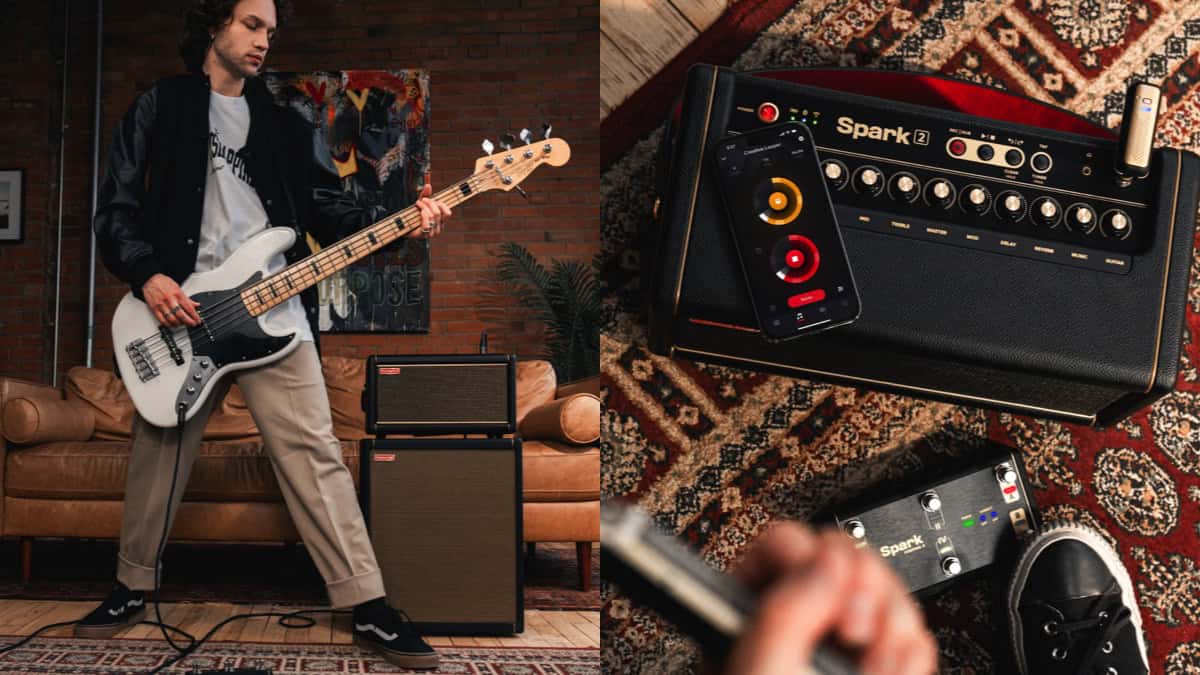
Positive Grid launches Spark 2, the next evolution of their cutting-edge smart guitar practice amplifiers and Bluetooth® speakers.
Engineered for acoustic, electric guitar, and bass, Spark 2 delivers an immersive practice and playing experience. Enjoy detailed sound and an all-new upgraded speaker design powered by Positive Grid’s exclusive Sonic IQ Computational Audio technology. With an onboard creative looper, optional battery power, and intuitive AI features for tone exploration and practice, Spark 2 is the gateway to a musical experience that goes beyond expectations.
Proprietary Audio and Advanced Technology
Spark 2 represents a leap forward in amplifier design. It integrates a new DSP amp modeling engine with double the processing power, and at 50 Watts, it packs 25% more volume than the original. Positive Grid’s proprietary Sonic IQ Computational Audio delivers incredibly detailed and dynamic sound. New HD amp models, enhanced by multi-band dynamic range compression and virtual bass augmentation, redefine the sonic landscape.
Equipped with two premium FRFR speakers and reflex ports, Spark 2 offers wide stereo imaging and broader frequency response, ensuring refined bass and clear, immersive sound.
Built-In Creative Looper
Spark 2’s built-in Groove Looper features hundreds of hyper-realistic drum tracks. From basic loops to multi-layered soundscapes or the ultimate jam session, this intuitive tool inspires endless creativity. Onboard amp controls provide quick, on-the-go looping functionality.
AI-Powered Tone and Smart Jam
Spark AI revolutionizes tone exploration. Describe any desired tone in the Spark app – from practical to outlandish – and Spark AI will suggest tones to audition or download. The more it’s used, the smarter it gets, delivering the perfect sound.
Additional smart features make it easy to practice, learn new songs and improve playing skills. Smart Jam listens to the user’s playing style and generates accompanying bass and drum parts, while Auto Chords analyzes any song streamed and displays the guitar chords in real time, to make learning and practicing new songs easier than ever.
Enhanced Hardware Design and Portability
Spark 2 allows for storing up to eight customizable presets directly on the amp for quick access to favorite sounds. Perfect the tone with large, visible onboard controls for looper, EQ, gain, reverb, and more.
Designed for convenience, an optional rechargeable battery provides up to 12 hours of playtime for on-the-go sessions. The new double-thick strap and durable build ensure easy and secure transport. Spark 2 is also Bluetooth® ready, allowing for music streaming and jamming along with favorite tracks anytime, anywhere.
Multiple Outputs and Advanced Features
Spark 2 offers versatile connectivity with a headphone out for private practice, stereo line outs for external audio sources, and a USB-C port which enables it to function as an audio interface. WiFi-enabled, Spark 2 allows convenient over-the-air firmware updates, keeping the amp up to date with the latest features and improvements.
“I’ve used a ton of practice amps while touring the world for over 38 years and it was always just a technical, bland exercise,” says guitar virtuoso, singer-songwriter and producer Nuno Bettencourt. “Spark 2 is like taking Madison Square Garden wherever you go – epic and versatile.”
Color Options
Available in Pearl or Black finish with a dark weave grille and premium finish.
Special Event, Upgrade Pricing & Availability
Join the special live premiere event featuring Nuno Bettencourt and surprise guests on August 1, 2024, at 8:00 am PT/11:00 am ET. Visit positivegrid.com/pages/livestream for more details and to sign up for a reminder.
Regularly USD $299, Spark 2 will be available at special early bird pricing during the pre-order period. Registered Spark 40 owners can also receive exclusive upgrade pricing.
For more information and to sign up for pre-order alerts, visit positivegrid.com/products/spark-2.
Gear Reviews
Gear Review: Exploring the Joyo Gloam – Sub Octave Fuzz Pedal for Bass
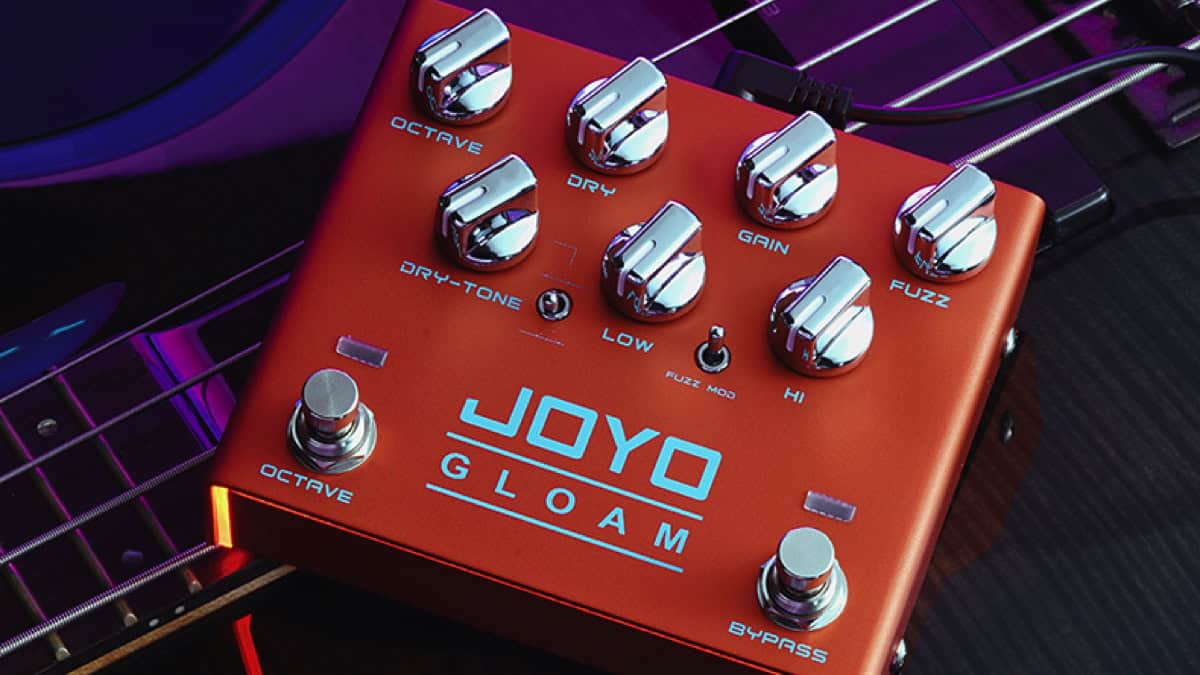
A review of the Joyo Gloam – Sub Octave Fuzz Pedal for Bass
Disclaimer: This pedal was kindly provided by Joyo for the purpose of this review. However, this does not influence our opinions or the content of our reviews. We strive to provide honest, unbiased, and accurate assessments to ensure that our readers receive truthful and helpful information.
Introduction: The Joyo Gloam is a sub-octave fuzz pedal specifically designed for bass players, combining modern sub-octave effects with rich fuzz tones. With two independently controlled circuits, the Gloam aims to provide a versatile range of sounds, from deep, aggressive fuzz to Moog-like synth effects. This review will explore the Gloam’s specifications, controls, and overall performance, highlighting both its strengths and areas for improvement.
Specifications:
- Dimensions: 130 * 110 * 50 mm
- Weight: 403g
- Working Voltage: DC 9V
- Controls: The Joyo Gloam features a comprehensive control set designed to provide bassists with a wide range of tonal options:
- Dry Tone: Adjusts the tone of the clean signal.
- Dry Volume: Controls the volume of the clean signal.
- Sub Octave Volume: Adjusts the volume of the sub octave signal.
- Gain: Controls the amount of gain in the fuzz circuit.
- Fuzz: Adjusts the intensity of the fuzz effect.
- Bass: Controls the bass frequencies in the fuzz circuit.
- Treble: Adjusts the treble frequencies in the fuzz circuit.
- Fuzz Mode Switch: Switches between two different fuzz modes.
- Dry Tone Frequency Switch: Selects between two different frequency points for the dry tone.
Performance: The Joyo Gloam excels in its dual-circuit design, offering both a sub octave and a fuzz channel that can be controlled individually. However, it’s important to note that the octaver cannot be used without the fuzz circuit activated; the only way to solo the octaver is by turning down the fuzz while both channels are engaged.
Fuzz Circuit: The fuzz circuit includes standard controls such as gain, volume, bass, and treble, along with a fuzz mode switch that toggles between two distinct fuzz modes. While one of the fuzz modes is highly usable and delivers a rich, aggressive tone, the other mode falls short and is less practical for most applications.
Octaver Circuit: The octaver circuit features controls for sub octave volume, clean volume, and clean tone, along with a dry tone frequency switch that provides two different frequency options. This allows for significant tonal versatility, enabling bassists to fine-tune their sound to match their preferences. Despite its limitation of being tied to the fuzz circuit, the octaver produces a deep, balanced sound that stands out.
Combined Effect: When used together, the fuzz and octaver circuits create a wide range of sounds, from classic, aggressive fuzz to synth-like tones reminiscent of a Moog synthesizer. This combination makes the Gloam a powerful tool for bassists seeking to experiment with their sound and achieve unique, textured tones.
Pros:
- Versatile Controls: Extensive control options for both fuzz and octaver circuits.
- Rich Tones: Delivers deep, aggressive fuzz and balanced octaver sounds.
- Sturdy Construction: Durable build quality ensures reliability.
- Wide Range of Sounds: Capable of producing everything from classic fuzz to synth-like effects.
Cons:
- Unusable Fuzz Mode: One of the fuzz modes is less practical.
- Dependent Octaver: Octaver cannot be used independently of the fuzz circuit.
Conclusion: In conclusion, the Joyo Gloam sub-octave fuzz pedal offers a versatile and powerful option for bassists looking to expand their tonal palette. Despite some flaws, the Gloam delivers impressive sounds and flexibility. Its combination of rich fuzz and deep octaver tones, coupled with a sturdy construction, makes it a valuable addition to any bassist’s pedalboard. For those seeking a modern bass distortion with the added depth of sub-octave effects, the Joyo Gloam is a compelling choice for a very compelling price.
Visit online at joyoaudio.com/product/281.html
Latest
July 22 Edition – This Week’s Top 10 Basses on Instagram
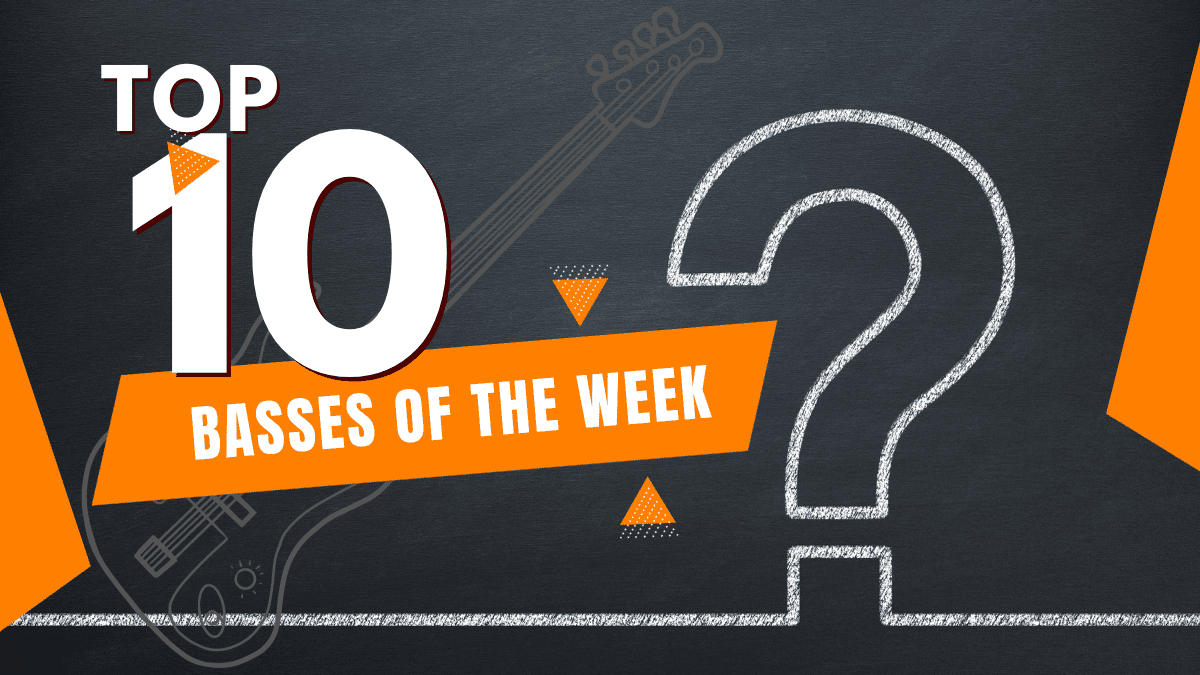
Check out our top 10 favorite basses on Instagram this week…
Click to follow Bass Musician on Instagram @bassmusicianmag
FEATURED @jermsbass @ramabass.ok @adamovicbasses @mgbassguitars @marleaux_bassguitars @overwaterbasses @mauriziouberbasses @elrickbasses @zemaitisguitars @sandbergguitars
Gear News
Behind the Strings: D’Addario’s Story Comes to Life in “Jim’s Corner” YouTube Series
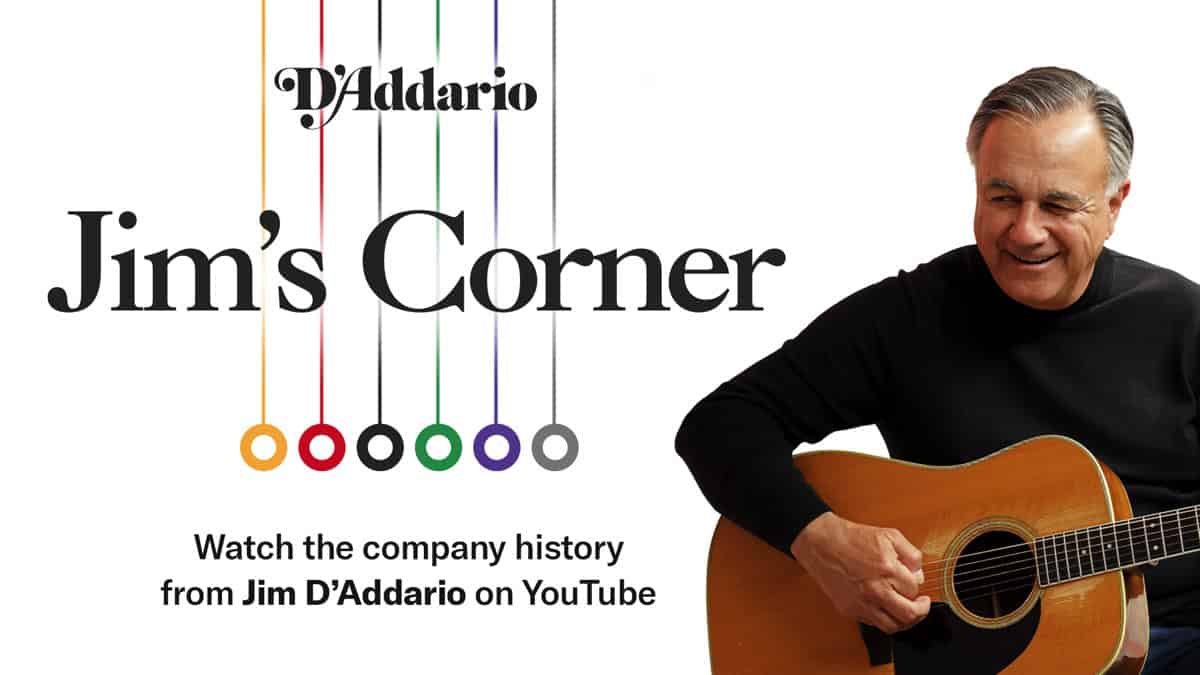
Behind the Strings – Jim’s Corner…
D’Addario & Co. proudly announces the launch of “Jim’s Corner,” a captivating new YouTube series telling the 400-year-old story of the D’Addario family creating the world’s largest music accessories company. This series features Jim D’Addario, Founder and Director of Innovation at D’Addario and Co., sharing his family’s remarkable journey from 17th century Italy to a 21st century global enterprise.
In the first four episodes now available, Jim D’Addario takes viewers back to the beginning, making strings from animal guts and knotting ukulele wire as a family around the television. Countless generations carried the passion forward until the 1970s when the company made it official and never looked back. Jim recounts the creation of strings that inspired legendary riffs, including one by The Who, the launch of Darco strings, the merger with Martin Guitars and the company’s humble beginnings with his wife, Janet and brother, John. Jim D’Addario’s firsthand accounts provide an intimate and personal perspective on the milestones and challenges that shaped D’Addario into the revered brand it is today.
Episode Highlights:
- Episode 1: The Early Days in Italy and the Move to America
- Episode 2: Inspiring Iconic Riffs and Legendary Partnerships
- Episode 3: Launching Darco Strings and Merging with Martin Guitars
- Episode 4: Building the D’Addario and Co. Legacy
Watch & Subscribe Now:
Join us in celebrating this incredible legacy by watching the first four episodes of “Jim’s Corner” on YouTube. New episodes will drop every month so please subscribe to our channel to ensure you don’t miss any future episodes and exclusive content from D’Addario & Co.: www.youtube.com/@daddarioandco
Gear News
Gear News: Aguilar Amplification Unveils Limited Edition NYC Gold Skyline Tone Hammer Preamp

Aguilar Amplification announces the release of the Limited Edition NYC Gold Skyline Tone Hammer Preamp pedal. Hand serialized 1-100, this exclusive edition celebrates Aguilar’s deep roots in New York City with a tribute to its iconic landmarks and vibrant spirit.
Born in the heart of NYC and raised on the road, the Tone Hammer Preamp DI has been an indispensable tool for bassists seeking inspiring tone and versatility. The new Limited Edition Gold NYC builds on this legacy with striking custom graphics encapsulating the essence of New York City. Featuring iconic landmarks from the Statue of Liberty to the Empire State Building, this pedal is not just a tool, but a piece of art embodying the soul of the city. Each unit features a sharp platinum silkscreen over a stunning matte gold sparkle finish, that is as visually captivating as it is sonically powerful.
The Tone Hammer is an essential preamp/direct box for every bassist’s toolbox. The Tone Hammer features fully sweepable midrange frequencies in addition to bass and treble controls. With the Tone Hammer’s pristine D.I. players are set for either studio or stage. To give this tone shaping unit the ultimate flexibility we introduce our proprietary Adaptive Gain Shaping circuitry (AGS). AGS allows the player to kick in an additional gain structure and EQ with the “stomp” of a button. You can go from modern slap sounds to vintage or overdriven. 18-volt operation gives the Tone Hammer plenty of headroom to reproduce the most dynamic playing styles. Separate gain and master controls allow players to dial in just the right gain structure for any instrument.
Aguilar Amplification’s Jordan Cortese adds, “With only 100 hand-numbered units available, this third iteration of our NYC edition Tone Hammer is a collector’s dream. “It’s a homage to our city’s monumental influence on music and culture and celebrates the craftsmanship and the story of Aguilar”.
Street price: $299.99 For more information, please visit www.aguilaramp.com














